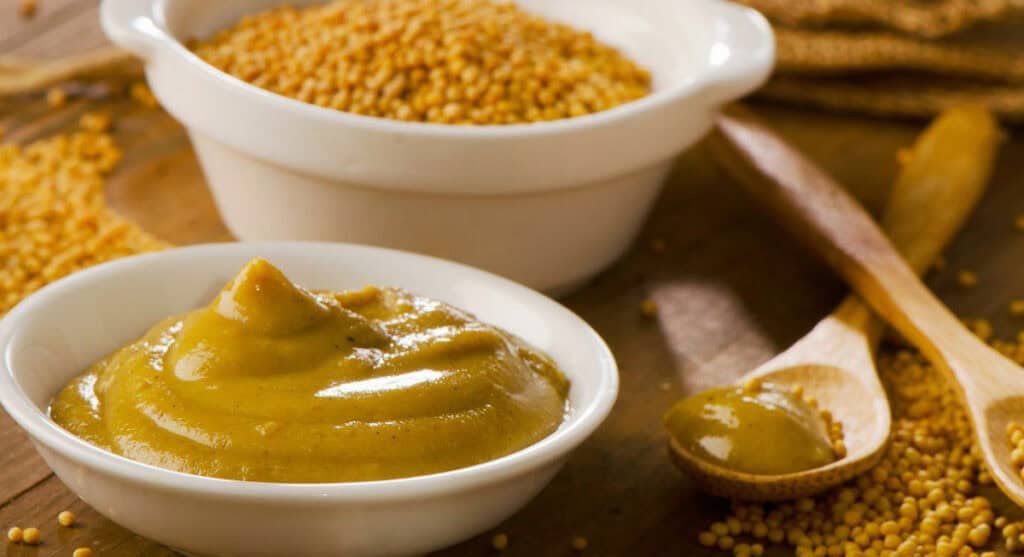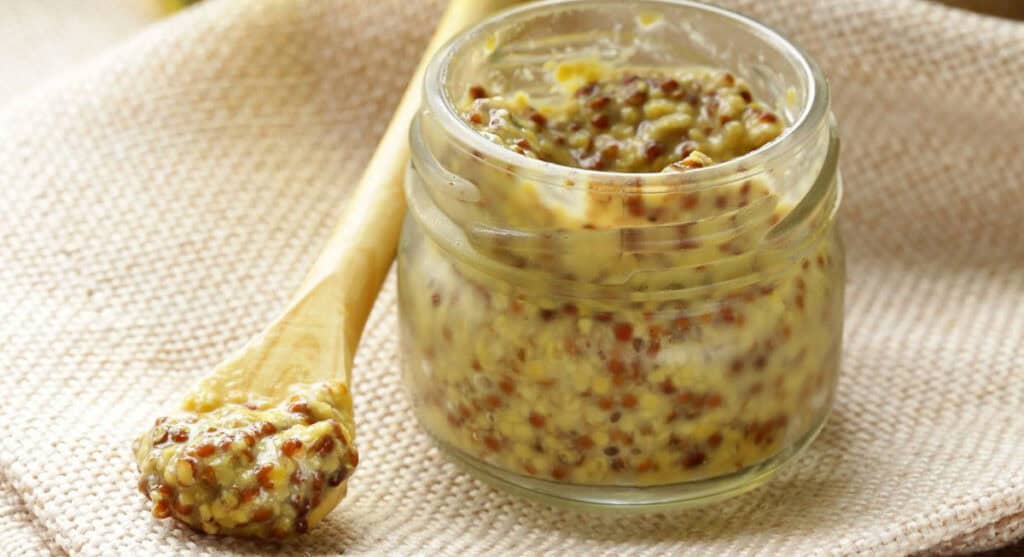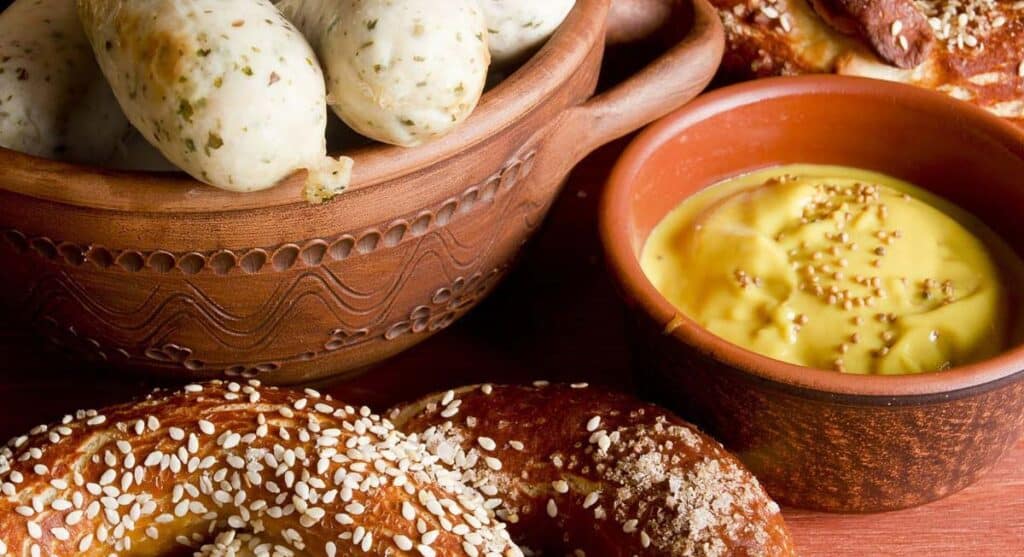Mustard is more than just a bright yellow condiment you squeeze onto hot dogs — it’s a flavor powerhouse. There’s a whole world of tangy, spicy and sweet types of mustard just waiting for you to discover. From the sharp kick of Dijon to the smooth sweetness of honey mustard, each offers its unique taste.

Trying different types of mustard can take your meals from ordinary to extraordinary. Whether you’re grilling bratwurst, preparing a vinaigrette or simply making a sandwich, choosing the right variety can make all the difference.
What is mustard?
Mustard is a condiment made from the seeds of mustard plants. The seeds are typically ground into a powder and mixed with liquids like water, vinegar or wine to create a paste.
The flavor of mustard can range from mild to intense, depending on the seeds used and the preparation method. The seeds can be ground finely or coarsely, offering many different mustard textures.
Types of Mustard
Mustard comes in a wide array of varieties, each with its own flavor profile, texture and uses. This condiment offers something for everyone: Mild to fiery, smooth to grainy.
Yellow mustard
Yellow mustard, commonly used on hot dogs and hamburgers, is made from ground mustard seeds mixed with vinegar, water and spices. Its smooth texture makes it easy to spread and it tastes tangy and slightly sour.
Not limited to sandwiches, this versatile condiment frequently finds its way into potato salad recipes and deviled egg fillings, adding a zesty kick to these classic dishes. Yellow mustard’s familiar taste and creamy consistency make it a go-to ingredient in many American kitchens.
Honey mustard
Honey mustard blends the sweetness of honey with the tangy kick of mustard. This popular condiment has a creamy texture and golden hue.
Honey mustard is a versatile sauce perfect for dipping chicken tenders or pretzels. It also makes a delicious salad dressing. Honey mustard pairs well with ham sandwiches and is a glaze for roasted meats.
“I use honey mustard the most because I find it gives the best blend of sweet and savory tastes. We love adding it to chicken dishes, marinades and even mixed with balsamic vinegar for salad dressings.”
— Shelby, Fit as a Mama Bear
Spicy brown mustard
Spicy brown mustard packs a bit more heat than yellow mustard. It is made with coarsely ground brown mustard seeds, giving it a darker color and grainy texture.
This mustard has a sharp, tangy flavor with a spicy kick. You’ll often find it on deli sandwiches, especially pastrami, corned beef or sausages. Spicy brown mustard also works well in marinades and sauces.
Dijon mustard
Hailing from Dijon, France, this well-known mustard is popular because of its smooth texture and intricate flavor profile. The secret to Dijon’s distinctive taste lies in adding white wine to the finely ground mustard seeds.
Dijon mustard has a sharp, tangy flavor and a subtle spicy kick. It’s a key ingredient in many French dishes and the backbone of countless vinaigrettes, sauces and marinades. Dijon also works well as a sandwich spread or a condiment for roasted meats.

Whole grain mustard
Whole grain or stone-ground mustard stands out thanks to the presence of whole or coarsely ground mustard seeds. This preparation allows you to see the individual seeds, which sets it apart from smooth mustard varieties.
The flavor is robust and slightly spicy, adding visual interest and texture to dishes. It is an excellent condiment for charcuterie boards since it complements the flavors of strong cheeses and cured meats.
“Stone ground mustard is my go-to for salad dressings and homemade vinaigrettes. It has a more earthy taste than regular Dijon mustard and works so well with leafy greens and veggies.”
— Casey Rooney, Get On My Salad Plate
Chinese hot mustard
Chinese hot mustard lives up to its name with a fiery kick. It’s made from brown or black mustard seeds with more heat than yellow seeds. It has a strong, sharp taste.
The heat is immediate and can be quite intense, often compared to the sensation of wasabi or horseradish, so use it sparingly. It adds a powerful punch to dipping sauces and marinades and goes well with dumplings or egg rolls.
English mustard
English mustard is known for its bright yellow color and fiery heat. It’s often sold as a powder you mix with water before use. It’s a staple condiment in British cuisine and is associated with brands like Colman’s, which has made mustard since 1814.
Much stronger than American mustard, it uses white and brown mustard seeds. In British cuisine, it’s served with roast beef or ham.
German mustard
German mustard comes in several tantalizing varieties. At the heart of this condiment family is a smooth, spicy brown mustard with a hint of sweetness, blending both yellow and brown mustard seeds.
Some German mustards incorporate horseradish for those who want an extra kick, turning up the heat. Whether savoring a juicy bratwurst or a warm, salted pretzel, German mustard is the perfect condiment.

Creole mustard
Creole mustard, born in the culinary melting pot of New Orleans, is a coarse-grained mustard with a spicy kick. It often includes horseradish and spices like paprika, delivering a tangy flavor with a subtle heat that lingers.
In the kitchen, Creole mustard is used in remoulade sauce and po’boy sandwiches. It complements the seafood-rich dishes of Louisiana cuisine, enhancing flavors without overpowering them.
Beer mustard
Beer mustard combines the zesty flavors of mustard with beer. Usually made with dark, robust brews like stouts or porters, it has a slightly bitter taste with hints of malt.
Use beer mustard as a dipping sauce for pretzels or sausages. It also adds a layer of flavor to cheese dips and salad dressings. Beer mustard pairs nicely with hearty meats like bratwurst or beef.
A condiment for every occasion
From mild yellow mustard to fiery Chinese hot mustard, there’s a type of mustard for every dish and preference. Exploring different mustards can enrich your cooking and add new flavors to your meals.
Understanding each type’s characteristics lets you make informed choices and discover new favorites. Next time you use mustard, try a different variety to expand your horizons.
Anne Jolly is the creator of the food blog Upstate Ramblings. She loves to cook with gadgets like an air fryer, sous vide or pressure cooker.